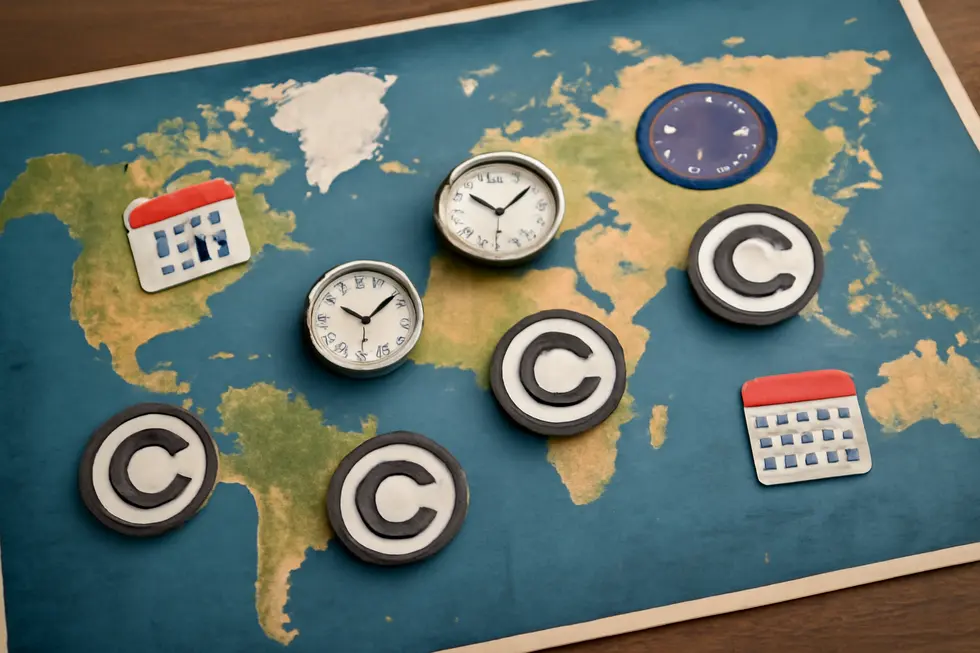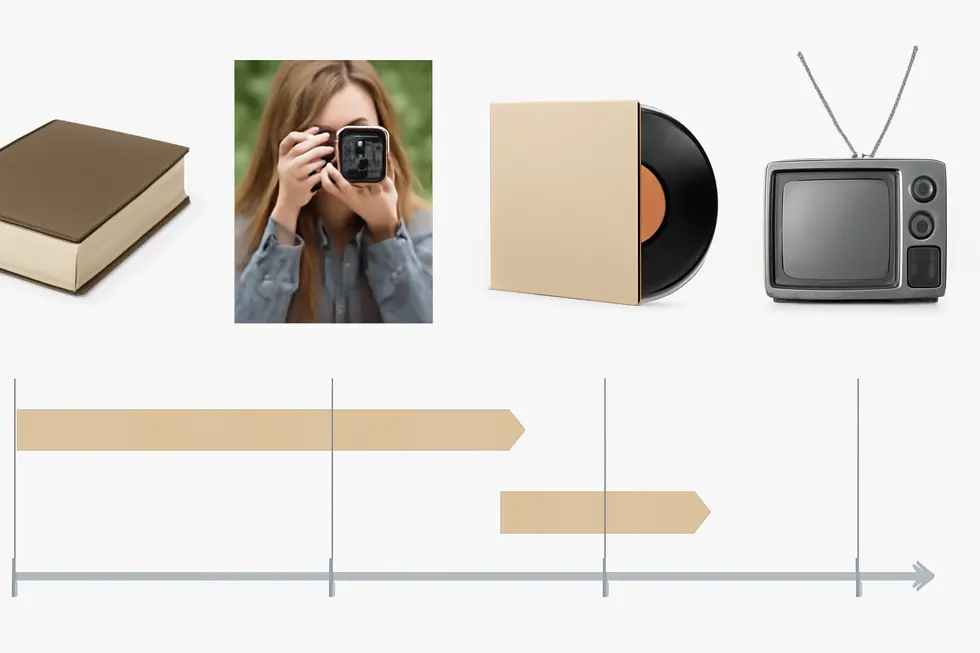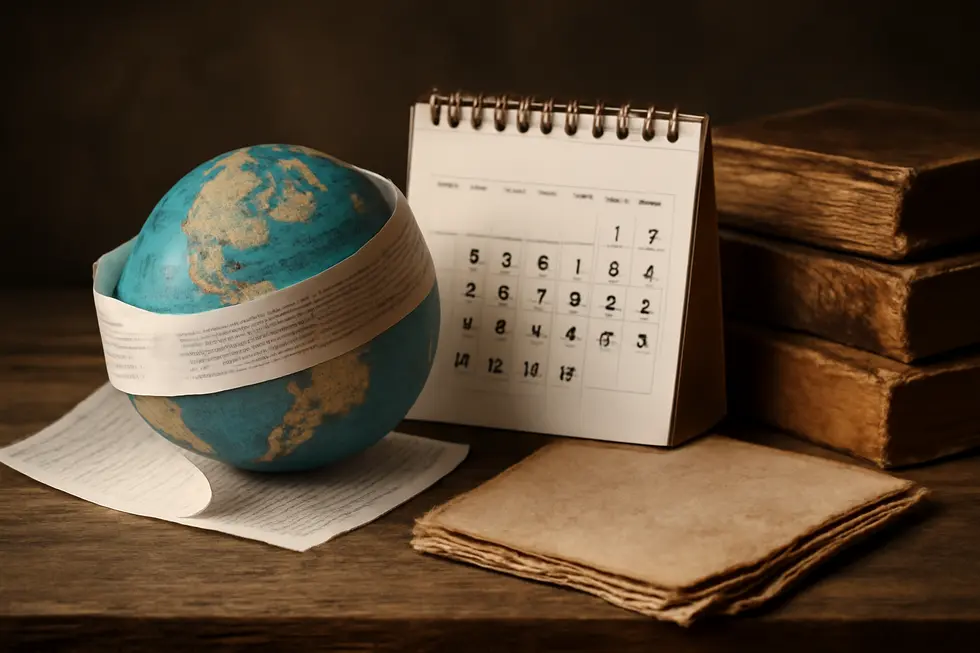Introduction
For business owners, protecting intellectual property is critical for sustaining growth and competitive advantage. Copyright safeguards a wide range of creative works, but how long that protection lasts can vary significantly depending on the type of work, jurisdiction, and publication date. Understanding these duration rules helps businesses manage risk, plan product lifecycles, and avoid infringement liabilities. This exploration starts with standard copyright terms and jurisdictional differences, then dives into specific durations tailored to various kinds of works relevant to businesses. Finally, it addresses international standards and public domain considerations to provide a comprehensive view that empowers you to make informed decisions about your intellectual property assets.
Tables of Contents
Chapter 1: How Long Does the Copyright Last: Standard Terms and Variations Across Jurisdictions
- The Global Norm of 70 Years Post-Mortem Copyright: Foundations and Jurisdictional Consistency
- Navigating Copyright Duration in Major Jurisdictions: Insights from the U.S., Japan, and the EU
- Navigating Copyright Duration: Unique Terms for Different Work Types and Authorship Across Jurisdictions
Chapter 2: How Long Does the Copyright Last: Specific Durations for Different Types of Works
- Lifespan of Copyright: From Individual Creators to Anonymous and Pseudonymous Works
- Navigating Copyright Terms: Published Versus Unpublished Works and Creation Dates
- Distinct Copyright Lifespans for Applied Art, Films, and Corporate Creations
Chapter 3: How Long Does the Copyright Last: International Standards and Public Domain Considerations
- Global Foundations of Copyright Duration: Life of the Author Plus Minimum Protection Periods
- Navigating U.S. and European Copyright Durations: Key Differences and Cross-Border Implications
- Navigating the Public Domain: When Copyrighted Works Become Freely Accessible
Chapter 1: How Long Does the Copyright Last: Standard Terms and Variations Across Jurisdictions

1. The Global Norm of 70 Years Post-Mortem Copyright: Foundations and Jurisdictional Consistency
Across many jurisdictions worldwide, the copyright term following an author’s death—known as post mortem auctoris—commonly extends for 70 years. This period begins from the author’s death and, in cases of joint authorship, from the death of the last surviving collaborator. This duration effectively balances protecting the economic rights of the author’s heirs while ensuring that, after a reasonable time, the work ultimately enriches the public domain.
This 70-year term has been widely embraced as a standard due largely to the international influence of the Berne Convention for the Protection of Literary and Artistic Works. The Berne Convention establishes a minimum duration of 50 years post-mortem, but many countries, including Nigeria, the European Union member states, and the United States, have extended this term to 70 years to provide stronger rights protection. Nigeria, for instance, directly aligns its copyright legislation with this norm, applying the 70-year term from the author’s death or last surviving author in joint works. This reflects a global trend toward harmonization in copyright laws that seek fairness and clarity in protecting creative expressions.
While the 70-year post-mortem term dominates as the benchmark, minor jurisdictional differences can arise due to national legislation nuances or the nature of specific works. Nonetheless, it remains the most recognized and widely implemented duration, serving as a reliable guideline for authors, heirs, and users globally. This long-established term underlines the ongoing effort to balance private intellectual property rights with the eventual transition of works into shared cultural heritage.
For further insight into the role of public domain in copyright terms, see this detailed discussion on copyright law and public domain.
Source: Copyright and the Public Domain in Nigeria – Legal Framework and Challenges
2. Navigating Copyright Duration in Major Jurisdictions: Insights from the U.S., Japan, and the EU
Copyright duration hinges on jurisdictional legislation but commonly reflects the author’s lifetime plus several decades of protection. In the United States, this baseline is set at life of the author plus 70 years for individual creations. However, when the copyright belongs to anonymous, pseudonymous, or works made for hire, the term shifts to either 95 years post-publication or 120 years from creation—whichever concludes first. This framework means that works published before 1929 entered the public domain in 2025, aligning with the Copyright Term Extension Act’s provisions.
Japan harmonized its copyright timeline with global standards, extending protection from life plus 50 years to life plus 70 years in 2018. This adjustment reflects Japan’s commitment to the Berne Convention’s recommendations and its trade relations, ensuring creators and their heirs benefit from prolonged rights. The European Union similarly applies a uniform rule across its member states: life of the author plus 70 years, applying widely to literary, musical, and artistic works. While some nuances arise with joint authorship or specific work categories, the overarching term remains consistent, anchored by the EU Copyright Directive.
Distinct copyright durations for anonymous, pseudonymous, or corporate-origin works focus on the date of publication or creation rather than the author’s lifespan. Moreover, special provisions exist in many jurisdictions for unique categories such as sound recordings or photographic works, which may have shorter protection periods.
These variations underscore the importance of understanding local copyright law intricacies when determining the term of protection. For creators, users, and legal professionals alike, knowing these jurisdictional distinctions is essential for proper rights management and compliance. For further insight on how copyright interacts with public domain status, explore copyright law and public domain considerations.
More detailed legal frameworks can be referenced through official sources such as the U.S. Copyright Office.
3. Navigating Copyright Duration: Unique Terms for Different Work Types and Authorship Across Jurisdictions
Copyright duration is not uniform; it fluctuates depending on the nature of the work, authorship, and the jurisdiction governing it. For individual creators of literary, musical, dramatic, and artistic works, many countries—including those following the Berne Convention like the UK—generally protect copyrights for the life of the author plus 70 years. This extended protection ensures creators and their heirs maintain exclusive rights well beyond the author’s lifetime.
However, complexities arise with different categories of works and authorship forms, particularly within the United States. Works published before 1930 reside in the public domain, freely available for use. For works published before 1964, copyright originally granted 28 years of protection, but required renewal; if renewed correctly, protection extends up to 95 years from the initial publication date. Post-1978 works mostly follow the life-plus-70-years rule, but anonymous, pseudonymous works, or “works made for hire” usually have a fixed maximum copyright term: the shorter between 95 years from publication or 120 years from creation.
Orphan works—those whose rights holders are unlocatable—introduce another layer of nuance. For example, the UK allows temporary licensing with fees for such works, balancing access and rights protection. Similarly, unpublished works formerly enjoyed potentially indefinite copyright durations, but legislative reforms like the UK’s CDPA 1988 have introduced transitional rules limiting this.
Corporate authorship, such as works made for hire, often differs fundamentally from individual authorship, with term limits determined by fixed periods rather than life spans. Jurisdictional variance is significant; some countries impose shorter terms or adapt rules based on local history and policy.
Because copyright begins upon fixation in a tangible medium, formal registration is not always required, yet the exact term in specific cases can be intricate. Whether dealing with anonymous works, international jurisdictions, or special cases like orphan works, consulting authoritative legal resources remains essential to clarify protection periods.
For a thorough understanding of how these terms apply, particularly in business contexts, see the detailed copyright information for books and official legislative sources such as the U.S. Copyright Act.
Chapter 2: How Long Does the Copyright Last: Specific Durations for Different Types of Works

1. Lifespan of Copyright: From Individual Creators to Anonymous and Pseudonymous Works
Copyright durations vary significantly depending on the identity of the author and the nature of authorship. For individual creators, the protection period generally spans the author’s lifetime plus an additional 70 years. When multiple authors collaborate, the copyright extends through 70 years after the death of the last surviving author. This convention aligns with the minimum standards prescribed by the Berne Convention and is widely adopted across jurisdictions including the United States and much of Europe.
However, attributing works to anonymous creators, pseudonymous authors, or those created under work-for-hire arrangements alters the duration formula. In these cases, copyright lasts either 95 years from the first publication date or 120 years from when the work was originally created, whichever expires sooner. This accounts for the unique challenges in tracking the lifespan of the actual creator or ownership changes and ensures a definitive expiration timeline.
The rationale behind these variable terms is balancing the economic and moral interests of authors and their heirs against the public’s eventual access to cultural works. For individual authors, life-plus-70 years grants ample opportunity for their estates to benefit from the intellectual property. For anonymous and corporate works, fixed terms avoid indefinite protection when the original author’s identity or lifespan is unavailable.
It is worth noting that some countries may adopt shorter terms, such as life plus 50 or 60 years. Still, life plus 70 years and the 95/120-year rules for anonymous or corporate authorship remain the most prevalent standards worldwide. For creators and users seeking accurate guidance, official copyright offices offer detailed country-specific information.
More insights on copyright durations and the nuances of public domain transitions can be explored through this detailed resource on copyright law and public domain.
2. Navigating Copyright Terms: Published Versus Unpublished Works and Creation Dates
Copyright duration depends heavily on factors such as whether a work is published or unpublished, the date of creation, and the nature of the author—whether an individual or a corporate entity. For works created on or after January 1, 1978, copyright protection endures for the life of the author plus 70 years, applying equally to published works and unpublished materials like diaries or personal letters. This extended protection guards unpublished works regardless of whether they ever saw formal publication.
In contrast, older works created before 1978 but published later follow distinct rules. For example, in the United States, works published between 1923 and 1963 were granted an initial 28-year term, which could be renewed for an additional 67 years, totaling up to 95 years of protection. Failure to renew this copyright resulted in those works entering the public domain after the initial term expired. Corporate authorship or “works made for hire” introduces yet another layer—these works enjoy protection for the shorter duration between 95 years from publication or 120 years from creation.
Beyond individual authorship, anonymous and pseudonymous works often have fixed copyright terms—commonly 70 years from their creation or publication, depending on the jurisdiction’s specific laws. International agreements like the Berne Convention establish a minimum copyright term of life plus 50 years, but many countries, including those in the European Union and the U.S., extend this to life plus 70 years, harmonizing protections on a global scale.
A critical detail is that copyright terms typically expire at the end of the calendar year in which the term concludes. While fair use exceptions allow limited utilization during the copyright period, they do not alter its duration.
Because copyright durations can vary dramatically depending on creation date, publication status, and author type, consulting authoritative resources is essential for accurate status determination. For more detailed guidance, see Oakland University’s comprehensive resource on determining copyright status.
3. Distinct Copyright Lifespans for Applied Art, Films, and Corporate Creations
Copyright duration varies considerably based on the nature of the work and its authorship, with particular distinctions for applied art, motion pictures, and corporate-owned creations. Applied art—design elements that combine aesthetic and functional qualities—typically enjoys a shorter copyright term than other creative works. In many jurisdictions, its protection lasts a minimum of 25 years, reflecting its hybrid commercial and artistic role.
Motion pictures receive more extensive coverage due to their complexity and commercial value. Most countries guarantee a minimum term of 50 years from either the creation date or first publication, although specific local rules may alter this period. These provisions acknowledge the considerable investment and cultural significance of films.
Corporate authorship introduces further nuance, especially in the United States. Works made for hire—created by employees within the scope of their work or commissioned under contract—receive protection measured differently than individual authorship. Here, copyright endures for the shorter of 95 years from publication or 120 years from creation. This substantial yet fixed term contrasts with the life-plus-years model applied to individual creators, whose works last for the author’s lifetime plus 70 years.
Historically, copyright terms in the U.S. evolved from an initial 28-year period for pre-1964 works, renewable to 95 years total, aligning with current corporate rules for longevity. The international Berne Convention sets a baseline of life plus 70 years for individuals, and a minimum of 50 years for anonymous or corporate works, creating a global framework widely adopted but customized to national contexts.
Importantly, moral rights under laws like the Visual Artists Rights Act in the U.S. protect an artist’s personal connection to visual works but do not extend the copyright’s duration.
For business owners and creators seeking clarity on copyright longevity and its implications, detailed guidance is available from the U.S. Copyright Office as well as specialized resources such as copyright information for business. Understanding these specifics ensures proper management of intellectual property across varied creative fields.
Chapter 3: How Long Does the Copyright Last: International Standards and Public Domain Considerations

1. Global Foundations of Copyright Duration: Life of the Author Plus Minimum Protection Periods
The foundation of modern copyright protection duration owes much to the Berne Convention, which sets a pivotal international baseline: copyright must last for the life of the author plus at least 50 years after their death. This principle ensures creators and their heirs enjoy exclusive rights for a significant period, balancing incentives for creativity against eventual public access. While 50 years post-mortem is the minimum standard required of member countries, many jurisdictions have adopted longer terms to further safeguard authors’ works.
Notably, the United States and European Union extend this protection period to life plus 70 years. This extension reflects evolving legislative choices, including U.S. adjustments influenced by various interests that have pushed beyond the minimum Berne requirement. Likewise, countries such as Denmark specify copyright lasting 70 years after the calendar year of an author’s death, which aligns with the broader European practice. For joint authorships or collaborative works like films and scripts, copyright often endures until 70 years following the death of the last surviving key contributor, ensuring comprehensive protection of the final creative voice.
Special categories like anonymous or pseudonymous creations receive fixed-term protections calculated from publication or creation date, commonly lasting around 70 years, which accommodates scenarios where an author’s identity is unknown. Such provisions maintain a balance between protecting rights and eventually integrating works into the public domain.
This international framework aims to harmonize copyright duration globally while leaving space for national variations. These distinctions underscore the importance for rights holders and users alike to understand specific local legislation. For creators and businesses navigating copyright lifespan, consulting authoritative legal resources is crucial.
For readers seeking further detailed insight into these international standards and variations, an excellent reference is the Berne Convention copyright durations overview. Additionally, exploring how copyright ties to intellectual property strategies can be useful, as discussed in this article about copyright information for books.
2. Navigating U.S. and European Copyright Durations: Key Differences and Cross-Border Implications
Copyright duration is fundamentally shaped by national laws, with the United States and the European Union exemplifying how jurisdictional nuances impact protection length. Both regions generally adhere to the principle of the author’s life plus 70 years, surpassing the Berne Convention’s minimum of 50 years post-mortem. However, the precise application varies notably.
In the United States, works created on or after January 1, 1978, receive copyright protection for the life of the author plus 70 years. Unique provisions apply to anonymous, pseudonymous works, and works made for hire, where protection lasts either 95 years from publication or 120 years from creation, depending on which term ends sooner. For works published before 1978, earlier rules required registration and renewal, typically providing up to 75 years of protection; many pre-1924 works have entered the public domain. Although copyright registration is no longer mandatory due to Berne Convention compliance since 1989, it remains a prerequisite to litigate infringement cases.
The European Union harmonizes its member states’ copyright terms by also mandating protection for the life of the author plus 70 years, aligning with U.S. standards but with regional legal uniformity. Despite this, local formalities can differ, especially concerning government works and formal registration processes.
Internationally, copyright remains a territorial right. While treaties like the Berne Convention promote mutual recognition, they do not fully unify copyright duration rules across borders. Consequently, creators and users engaging in licensing or litigation must consider where a work is protected to understand its valid term. Overlooking country-specific rules risks infringement or forfeiting rights.
For detailed guidance, consulting authoritative resources such as the U.S. Copyright Office is essential. Moreover, comprehending these jurisdictional frameworks aids in managing intellectual property effectively within the global landscape, ensuring respect for both legal protections and the public domain.
For further insights, explore this comprehensive overview of copyright durations by country.
3. Navigating the Public Domain: When Copyrighted Works Become Freely Accessible
Navigating the Public Domain: When Copyrighted Works Become Freely Accessible
Understanding the transition from copyright protection to public domain status is essential for grasping how creative works become available for unrestricted public use. Copyright duration varies with the type of work, date of creation, and jurisdiction, but common rules generally determine when a work’s exclusive rights expire and it enters the public domain.
For works created on or after January 1, 1978, copyright lasts for the life of the author plus 70 years. Anonymous, pseudonymous, or works made for hire, however, have a set term of either 95 years from publication or 120 years from creation, whichever expires first. Works published before 1924 are typically in the public domain in the United States, while those published between 1924 and 1977 follow more complex rules due to various law amendments and renewal requirements.
Importantly, copyright terms conclude at the end of the calendar year of expiration, so works enter the public domain on January 1 of the following year. Once in the public domain, anyone may use, reproduce, or adapt the original work without permission or payment, unleashing cultural and creative freedom.
Yet, the public domain status can be intricate. New editions containing original commentary or annotations might hold new copyrights, even if the underlying work is free to use. Additionally, international differences exist; while the Berne Convention mandates a minimum protection of life plus 50 years, several countries extend this term, complicating cross-border use. For instance, the U.S. restored copyright on certain foreign works previously deemed public domain under the Uruguay Round Agreements Act.
Legal nuances also emerge because copyright only covers original expression, not ideas or facts, and technological advances challenge traditional frameworks. The rise of AI-generated content and user-driven platforms complicates definitions of ownership and infringement, demanding evolving legal interpretation.
For comprehensive guidance on copyright and public domain distinctions, exploring copyright law and public domain provides detailed insights.
This complex interplay of laws, creative expression, and advancing technology shapes the precise moment when copyrighted materials fully enter public access, marking a critical point in intellectual property management and cultural heritage preservation.
Reference: Copyright terms and public domain date mechanics in U.S. law.
Final thoughts
Grasping how long copyright lasts is essential for business owners who want to fully leverage and protect their creative assets. From standard copyright terms rooted in the life of the author plus 70 years to special provisions governing photographs, sound recordings, and broadcasts, the duration of protection can directly impact your business’s intellectual property strategy. Appreciating jurisdictional differences and international benchmarks, as well as recognizing when works enter the public domain, equips you to navigate copyright complexities skillfully. Taking proactive steps to understand these nuances ensures your business’s valuable creations remain secure—and available for innovation—at the right times.
Your IP is the foundation of your success – let’s protect it together before it’s too late. We can’t wait to help you turn your ideas into legally secured assets.
About us
undefined


